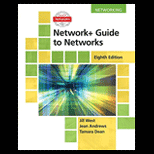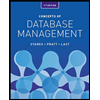
Computer Networking: A Top-Down Approach (7th Edition)
7th Edition
ISBN: 9780133594140
Author: James Kurose, Keith Ross
Publisher: PEARSON
expand_more
expand_more
format_list_bulleted
Question
Chapter 7, Problem P8P
a.
Program Plan Intro
Given scenario:
- The network consists of four wireless nodes A, B, C and D. The shaded region in the given figure is radio coverage of the four nodes and all the nodes share the same frequency.
- If A transmits only send/ received by the node B; if B transmits both A and C can send/ receive from the node B; if C transmits both B and D can send/ receive from C; if D transmits only C can send/ receive from D.
- If the node A wants to send the message to the node D, first a message send to the node B, which then sends to node C and finally a message reaches the targeted node D.
- The time is slotted, with a message transmission time taking exactly one time slot.
b.
Program Plan Intro
Given scenario:
- The network consists of four wireless nodes A, B, C and D. The shaded region in the given figure is radio coverage of the four nodes and all the nodes share the same frequency.
- If A transmits only send/ received by the node B; if B transmits both A and C can send/ receive from the node B; if C transmits both B and D can send/ receive from C; if D transmits only C can send/ receive from D.
- If the node A wants to send the message to the node D, first a message send to the node B, which then sends to node C and finally a message reaches the targeted node D.
- The time is slotted, with a message transmission time taking exactly one time slot.
c.
Program Plan Intro
Given scenario:
- The network consists of four wireless nodes A, B, C and D. The shaded region in the given figure is radio coverage of the four nodes and all the nodes share the same frequency.
- If A transmits only send/ received by the node B; if B transmits both A and C can send/ receive from the node B; if C transmits both B and D can send/ receive from C; if D transmits only C can send/ receive from D.
- If the node A wants to send the message to the node D, first a message send to the node B, which then sends to node C and finally a message reaches the targeted node D.
- The time is slotted, with a message transmission time taking exactly one time slot.
d.
Program Plan Intro
Given scenario:
- The network consists of four wireless nodes A, B, C and D. The shaded region in the given figure is radio coverage of the four nodes and all the nodes share the same frequency.
- If A transmits only send/ received by the node B; if B transmits both A and C can send/ receive from the node B; if C transmits both B and D can send/ receive from C; if D transmits only C can send/ receive from D.
- If the node A wants to send the message to the node D, first a message send to the node B, which then sends to node C and finally a message reaches the targeted node D.
- The time is slotted, with a message transmission time taking exactly one time slot.
e.
Explanation of Solution
- Maximum rate which a data message can be transferred from C to A with ACK:
- The maximum rate which a data message can be transferred from C to A is one message per four slots (1 message/ 4 slots), in slot 1 a message sends from A to B, in slot 2 a message sends from B to C, in slot 3 the ACK sends from C to B and in slot 4 the ACK sends from B to A.
- Combined maximum rate which a data message can be transferred from A to B and D to C with ACK:
- The combined maximum rate which a data message can be transferred from A to B and D to C are two ...
- The maximum rate which a data message can be transferred from C to A is one message per four slots (1 message/ 4 slots), in slot 1 a message sends from A to B, in slot 2 a message sends from B to C, in slot 3 the ACK sends from C to B and in slot 4 the ACK sends from B to A.
- The combined maximum rate which a data message can be transferred from A to B and D to C are two ...
Expert Solution & Answer
Want to see the full answer?
Check out a sample textbook solution
Students have asked these similar questions
I want to explain my
work in Python
botnets and it is
completely working
on the tkinter function
with an explanation
of how I can work on
it with an introduction
about what it is and
what its benefit is
When you connect
your device to Wi-Fi,
what happens "under
the hood"?
Explain in detail, with
pictures, what it's
like.
You will write a program that allows the user to keep track of college locations and details about each location. To begin you will create a College python class that keeps track of the csollege's unique id number, name, address, phone number, maximum students, and average tuition cost.
Once you have built the College class, you will write a program that stores College objects in a dictionary while using the College's unique id number as the key.
The program should display a menu in this order that lets the user:
1) Add a new College
2) Look up a College
4) Delete an existing College
5) Change an existing College's name, address, phone number, maximum guests, and average tuition cost.
6) Exit the program
Chapter 7 Solutions
Computer Networking: A Top-Down Approach (7th Edition)
Ch. 7 - Prob. R1RQCh. 7 - Prob. R2RQCh. 7 - Prob. R3RQCh. 7 - Prob. R4RQCh. 7 - Prob. R5RQCh. 7 - Prob. R6RQCh. 7 - Prob. R7RQCh. 7 - Prob. R8RQCh. 7 - Prob. R9RQCh. 7 - Prob. R10RQ
Ch. 7 - Prob. R11RQCh. 7 - Prob. R12RQCh. 7 - Prob. R13RQCh. 7 - Prob. R14RQCh. 7 - Prob. R15RQCh. 7 - Prob. R16RQCh. 7 - Prob. R17RQCh. 7 - Prob. R18RQCh. 7 - Prob. R19RQCh. 7 - Prob. R20RQCh. 7 - Prob. R21RQCh. 7 - Prob. R22RQCh. 7 - Prob. R23RQCh. 7 - Prob. P1PCh. 7 - Prob. P2PCh. 7 - Prob. P3PCh. 7 - Prob. P5PCh. 7 - Prob. P6PCh. 7 - Prob. P7PCh. 7 - Prob. P8PCh. 7 - Prob. P10PCh. 7 - Prob. P11PCh. 7 - Prob. P12PCh. 7 - Prob. P13PCh. 7 - Prob. P14PCh. 7 - Prob. P15PCh. 7 - Prob. P16P
Knowledge Booster
Similar questions
- I need help with this problem and an step by step explanation of the solution from the image described below. (Introduction to Signals and Systems)arrow_forwardI need help with this problem and an step by step explanation of the solution from the image described below. (Introduction to Signals and Systems)arrow_forwardI need help with this problem and an step by step explanation of the solution from the image described below. (Introduction to Signals and Systems)arrow_forward
- I need help with this problem and an step by step explanation of the solution from the image described below. (Introduction to Signals and Systems)arrow_forwardHello, Please read the provided text carefully—everything is detailed there. I need high-quality diagrams for both cases: Student A and Student B, showing the teacher teaching them through knowledge distillation. Each case should be represented as a separate image. The knowledge distillation process must be clearly illustrated in both. I’ve attached an image that shows the level of clarity I’m aiming for. Please do not use AI-generated diagrams. If I wanted that, I could do it myself using ChatGPT Premium. I’m looking for support from a real human expert—and I know you can help. " 1. Teacher Model Architecture (T) Dataset C: Clean data with complete inputs and labels Architecture Input Embedding Layer Converts multivariate sensor inputs into dense vectors. Positional Encoding Adds time-step order information to each embedding. Transformer Encoder Stack (repeated N times) Multi-Head Self-Attention: Captures temporal dependencies across time steps. Add…arrow_forward(connection)? Q1: Define the BGP ? Ebgp vs I bgp, and how do I advertise? With a drawing example QT: Explain how to make messages in the BGP protocol. Q: What is concept the hot potato routing in BGP? Q: What are the criteria for BGP route selection? Qo: Define the concept of Spanning Tree Protocol. Explain in detail and draw the figures. Q1: What happens when STP is disabled? QV: Define the concept of broadcast storm. QA: List and explain the Steps to a Loop-Free Topology when using the Spanning Tree Algorithm and Spanning Tree Protocol in a four-step process. I want a typical and concise Solutionarrow_forward
- WATCH THE VIDEO ABOUT MODELLING OR SPECIFICATION PHASE AND ANSWER THE FOLLOWING QUESTIONS: https://www.youtube.com/watch?v=uoIxDeAyfdo 1.- DEFINE SPECIFICATION OR MODELLING 2.- WRITE DOWN THE 3 REQUIREMENTS SPECIFICATION TECHNIQUES OR FORMATS 3.-DEFINE USE CASES 4.-DEFINE SRS 5.-DEFINE USER STORIES 6.- IS IT RECOMMENDABLE TO USE SRS DOCUMENTS IN AGILE METHODOLOGY? WHY? 7.- HOW DO YOU KNOW WHICH TECHNIQUE OR FORMAT TO USE? 8.- WRITE DOWN THE USE CASE COMPONENTSarrow_forwardREADING AND LISTENING ACTIVITIES BASED ON THE VIDEO: “REQUIREMENT ELICITATION “ Watch the following video and look for the answer to the following questions: https://www.youtube.com/watch?v=pSQRetBoaRE&t=24s 1.-NAME THE 2 PHASES OF THE REQUIREMENT ENGINEERING PROCESS 2.-NAME AT LEAST 7 ELICITATION TECHNIQUES TO COLLECT THE INFORMATION REQUIRED 3.-REFER TO THE NUMBER OF QUESTIONS AND TYPE OF QUESTIONS THAT SHOULD BE ASKED TO THE DIFFERENT STAKEHOLDERS. 4.-NAME THE DIFFERENT TYPES OF PROBLEMS YOU CAN ENCOUNTER DURING THE REQUIREMENT ELICITATION PROCESS 5.- ACCORDING TO THE VIDEO, WHICH TYPES OF TECHNIQUES SHOULD YOU USE, WHICH ONES WOULD YOU USE ACCORDING TO PROFESSOR SHERRIFF ‘S RECOMMENDATIONS?arrow_forwardCan you please show me how I can do this on google sheets. For the spreadsheet you need to create a multi page sheets thing that uses all the techniques of counts/sums and graph showing how many contracts have been returned for each grade...you can make up the data (let's say in grade 9 I got 15 contracted back with fake data that I want you to show me how to create on google spreadsheet) For grade 10 i got 20 contracts signed, for grade 11 I got 16 contracts and for grade 12 I got 25 contracts back. Can you help me pls. Thanks so much. Make sure you have graphs on the page and also the sum written as a formula and the numbers filled in the columns.arrow_forward
- I need help with this problem and an step by step explanation of the solution from the image described below. (Introduction to Signals and Systems)arrow_forwardGoal: Understand how to build a concurrent server and deal with signals Description: Use TCP socket programming in C to implement a pair of client and server programs. The client simply asks the user to enter a string (null-terminated), and then displays a menu for the user to select an operation on that string. The string and the type of operation are sent to the child server which performs the required operation and returns the result back to the client. That is, the server (parent) creates a child for each request of the client (you need to print the port and IP address of the client on the server terminal). Then it waits for the child to finish processing client's request and prints the process ID of the terminated child. The connection between your client and server should stay open, so that the client can send another request. However, the exit will happen when the user sends the client program the SIGQUIT signal. The handler will print a notifying message (for example, "Good…arrow_forwardI need help with this problem and an step by step explanation of the solution from the image described below. (Introduction to Signals and Systems)arrow_forward
arrow_back_ios
SEE MORE QUESTIONS
arrow_forward_ios
Recommended textbooks for you
 Computer Networking: A Top-Down Approach (7th Edi...Computer EngineeringISBN:9780133594140Author:James Kurose, Keith RossPublisher:PEARSON
Computer Networking: A Top-Down Approach (7th Edi...Computer EngineeringISBN:9780133594140Author:James Kurose, Keith RossPublisher:PEARSON Computer Organization and Design MIPS Edition, Fi...Computer EngineeringISBN:9780124077263Author:David A. Patterson, John L. HennessyPublisher:Elsevier Science
Computer Organization and Design MIPS Edition, Fi...Computer EngineeringISBN:9780124077263Author:David A. Patterson, John L. HennessyPublisher:Elsevier Science Network+ Guide to Networks (MindTap Course List)Computer EngineeringISBN:9781337569330Author:Jill West, Tamara Dean, Jean AndrewsPublisher:Cengage Learning
Network+ Guide to Networks (MindTap Course List)Computer EngineeringISBN:9781337569330Author:Jill West, Tamara Dean, Jean AndrewsPublisher:Cengage Learning Concepts of Database ManagementComputer EngineeringISBN:9781337093422Author:Joy L. Starks, Philip J. Pratt, Mary Z. LastPublisher:Cengage Learning
Concepts of Database ManagementComputer EngineeringISBN:9781337093422Author:Joy L. Starks, Philip J. Pratt, Mary Z. LastPublisher:Cengage Learning Prelude to ProgrammingComputer EngineeringISBN:9780133750423Author:VENIT, StewartPublisher:Pearson Education
Prelude to ProgrammingComputer EngineeringISBN:9780133750423Author:VENIT, StewartPublisher:Pearson Education Sc Business Data Communications and Networking, T...Computer EngineeringISBN:9781119368830Author:FITZGERALDPublisher:WILEY
Sc Business Data Communications and Networking, T...Computer EngineeringISBN:9781119368830Author:FITZGERALDPublisher:WILEY

Computer Networking: A Top-Down Approach (7th Edi...
Computer Engineering
ISBN:9780133594140
Author:James Kurose, Keith Ross
Publisher:PEARSON

Computer Organization and Design MIPS Edition, Fi...
Computer Engineering
ISBN:9780124077263
Author:David A. Patterson, John L. Hennessy
Publisher:Elsevier Science

Network+ Guide to Networks (MindTap Course List)
Computer Engineering
ISBN:9781337569330
Author:Jill West, Tamara Dean, Jean Andrews
Publisher:Cengage Learning

Concepts of Database Management
Computer Engineering
ISBN:9781337093422
Author:Joy L. Starks, Philip J. Pratt, Mary Z. Last
Publisher:Cengage Learning

Prelude to Programming
Computer Engineering
ISBN:9780133750423
Author:VENIT, Stewart
Publisher:Pearson Education

Sc Business Data Communications and Networking, T...
Computer Engineering
ISBN:9781119368830
Author:FITZGERALD
Publisher:WILEY